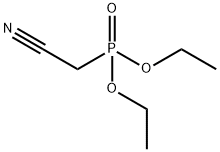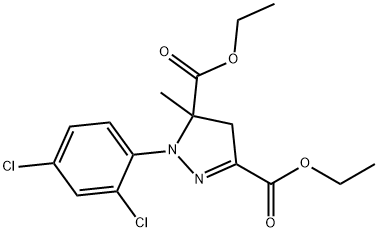Diethyl chlorophosphate
Synonym(s):Diethyl phosphorochloridate
- CAS NO.:814-49-3
- Empirical Formula: C4H10ClO3P
- Molecular Weight: 172.55
- MDL number: MFCD00009075
- EINECS: 212-396-4
- SAFETY DATA SHEET (SDS)
- Update Date: 2025-01-27 09:38:02

What is Diethyl chlorophosphate?
Description
Diethyl chlorophosphate is a combustible,clear liquid with an unpleasant odor. Molecularweight=172.76; Boiling point=60℃ at 2.0 mmHg; 81℃at 6.0 mmHg. Freezing/Melting point=0℃. HazardIdentification (based on NFPA-704 M Rating System):Health 4, Flammability 2, Reactivity 2 . Reacts withwater.
Chemical properties
clear colorless to light yellow liquid
The Uses of Diethyl chlorophosphate
A phosphorous halide used for biochemical research. Also used as an intermediate in organic synthesis.
What are the applications of Application
Diethyl chlorophosphate is a phosphorous halide used for biochemical research
General Description
Clear liquid. Diethyl chlorophosphate is used as an intermediate in organic synthesis.
Reactivity Profile
Organophosphates, such as Diethyl chlorophosphate, are susceptible to formation of highly toxic and flammable phosphine gas in the presence of strong reducing agents such as hydrides. Partial oxidation by oxidizing agents may result in the release of toxic phosphorus oxides.
Health Hazard
Diethyl chlorophosphate is a cholinesterase inhibitor. It has high oral and very high dermal toxicity. It is a skin irritant. It is also toxic by inhalation.
Fire Hazard
Emits very toxic fumes of chloride and phosphorus oxides when heated to decomposition.
Safety Profile
Deadly poison by skin contact. Poison by ingestion. A cholinesterase inhibitor. See also PARATHION. Trace HCl catalyzes a hazardous reaction during the preparation of diethyl phosphate from diethyl chlorophosphate. When heated to decomposition it emits very toxic fumes of Cl and POx.
Potential Exposure
This material may be used as an intermediate in the manufacture of pesticides and chemical warfare agents.
First aid
If this chemical gets into the eyes, remove anycontact lenses at once and irrigate immediately for at least15 min, occasionally lifting upper and lower lids. Seek medical attention immediately. If this chemical contacts theskin, remove contaminated clothing and wash immediatelywith soap and water. Speed in removing material from skinis of extreme importance. Shampoo hair promptly if contaminated. Seek medical attention immediately. If thischemical has been inhaled, remove from exposure, begin rescue breathing (using universal precautions, includingresuscitation mask) if breathing has stopped and CPR ifheart action has stopped. Transfer promptly to a medicalfacility. When this chemical has been swallowed, get medical attention. Give conscious victims water or milk.Promote excretion by administering saline cathartic or sorbitol. Do not make an unconscious person vomit.
Storage
Color Code—Blue: Health Hazard/Poison: Storein a secure poison location. Prior to working with thischemical you should be trained on its proper handling andstorage. Store in tightly closed containers in a cool, wellventilated area away from oxidizers and reducing agents.Where possible, automatically pump liquid from drums orother storage containers to process containers.
Shipping
Organophosphorus compound, toxic n.o.s.requires a label of “POISONOUS/TOXIC MATERIALS.”These materials fall in Hazard Class 6.1 and Packing GroupII.
Incompatibilities
Contact with oxidizers may cause therelease of phosphorous oxides. Contact with strong reducingagents, such as hydrides, may cause the formation of flammable and toxic phosphine gas. Strong oxidizers, bases.
Properties of Diethyl chlorophosphate
| Melting point: | 95-96 °C |
| Boiling point: | 60 °C2 mm Hg(lit.) |
| Density | 1.194 g/mL at 25 °C(lit.) |
| vapor density | 5.94 (vs air) |
| vapor pressure | 0.1 mm Hg ( 25 °C) |
| refractive index | n |
| Flash point: | 142 °F |
| storage temp. | 2-8°C |
| solubility | Chloroform (Sparingly) |
| form | Liquid |
| color | Clear colorless to light yellow |
| Water Solubility | Soluble in alcohol and chloroform. Slightly soluble in water. |
| Sensitive | Moisture Sensitive |
| BRN | 471433 |
| Stability: | Hygroscopic, Moisture Sensitive |
| CAS DataBase Reference | 814-49-3(CAS DataBase Reference) |
| NIST Chemistry Reference | Phosphorochloridic acid, diethyl ester(814-49-3) |
| EPA Substance Registry System | Diethyl chlorophosphate (814-49-3) |
Safety information for Diethyl chlorophosphate
| Signal word | Danger |
| Pictogram(s) |
 Skull and Crossbones Acute Toxicity GHS06 |
| GHS Hazard Statements |
H331:Acute toxicity,inhalation |
| Precautionary Statement Codes |
P262:Do not get in eyes, on skin, or on clothing. P264:Wash hands thoroughly after handling. P264:Wash skin thouroughly after handling. P280:Wear protective gloves/protective clothing/eye protection/face protection. P301+P310:IF SWALLOWED: Immediately call a POISON CENTER or doctor/physician. |
Computed Descriptors for Diethyl chlorophosphate
| InChIKey | LGTLXDJOAJDFLR-UHFFFAOYSA-N |
Diethyl chlorophosphate manufacturer
RVR Labs Pvt Ltd
OctaneX Labs
New Products
4,4-Difluoropiperidine hydrochloride tert-butyl 9-methoxy-3-azaspiro[5.5]undecane-3-carboxylate Indole Methyl Resin N-Isopropylurea N,N-Dicyclohexylcarbodiimide(DCC) MELDRUMS ACID 5-METHYLISOXAZOLE-4-CARBOXYLIC ACID Magnessium Bis glycinate Zinc ascorbate 1-bromo-2-butyne 2-acetamidophenol 9(10H)-anthracenone Erythrosin B, 4-Piperidinopiperidine 2-((4-morpholinophenylamino) (methylthio) methylene) malononitrile 2,4-dihydroxybenzaldehyde 3-(4-morpholinophenylamino)-5-amino-1H-pyrazole-4-carbonitrile Methyl 2-methylquinoline-6-carboxylate 2,6-dichloro-4-nitropyridine 4-Bromo-2-chlorobenzonitrile 2-(benzylamino)acetic acid hydrochloride 4-(tert-Butoxycarbonylamino)but- 2-ynoic acid 3,4-dihydro-2H-benzo[b][1,4]dioxepine 1-Phenyl-1-cycloprppanecarboxylicacidRelated products of tetrahydrofuran








You may like
-
 Diethyl chlorophosphate, 97%+ CAS 814-49-3View Details
Diethyl chlorophosphate, 97%+ CAS 814-49-3View Details
814-49-3 -
 Diethyl chlorophosphate CAS 814-49-3View Details
Diethyl chlorophosphate CAS 814-49-3View Details
814-49-3 -
 814-49-3 Diethyl chlorophosphate 98%View Details
814-49-3 Diethyl chlorophosphate 98%View Details
814-49-3 -
 Diethyl Chlorophosphate Cas No. 212-396-4, 814-49-3View Details
Diethyl Chlorophosphate Cas No. 212-396-4, 814-49-3View Details
814-49-3 -
 3-(4-amino-1-oxoisoindolin-2-yl)-1-methylpiperidine-2,6-dione 98%View Details
3-(4-amino-1-oxoisoindolin-2-yl)-1-methylpiperidine-2,6-dione 98%View Details -
 20677-73-0 (2,2-diethoxyethyl)methylamine 98%View Details
20677-73-0 (2,2-diethoxyethyl)methylamine 98%View Details
20677-73-0 -
 3-(4-(hydroxyamino)-1-oxoisoindolin-2-yl)piperidine-2,6-dione 98%View Details
3-(4-(hydroxyamino)-1-oxoisoindolin-2-yl)piperidine-2,6-dione 98%View Details -
 57381-49-4 2-bromo-4-chlorobenzonitrile 98%View Details
57381-49-4 2-bromo-4-chlorobenzonitrile 98%View Details
57381-49-4
